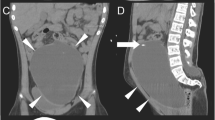Abstract
Abdominal cerebrospinal fluid pseudocyst is an infrequent complication of ventriculoperitoneal (VP) shunts. We reviewed ten patients with abdominal pseudocyst. There were five girls and five boys, aged between 4 months and 14 years. The number of shunt procedures prior to the presentation varied between one and five. Only one patient had had a previous shunt infection. No patients had undergone prior abdominal surgery other than VP shunting. The time from the last shunting procedure to the development of abdominal pseudocyst ranged from 3 weeks to 5 years. Presenting symptoms and signs were mainly related to abdominal complaints in all patients. Three patients also had the signs of shunt malfunction. The diagnosis was made by ultrasound in all patients. Shunt infection was determined in six patients. Repositioning of the peritoneal catheter seemed to have a higher rate of recurrence. The diagnosis of abdominal pseudocyst should be considered in VP-shunted patients presenting with abdominal complaints.
Similar content being viewed by others
References
Ames RH (1967) Ventriculoperitoneal shunts in the management of hydrocephalus. J Neurosurg 27: 525–529
Blount JP, Campbell JA, Haines SJ (1993) Complications in ventricular cerebrospinal fluid shunting. Neurosurg Clin N Am 4:633–656
Briggs IR, Hendry GMA, Minns RA (1984) Abdominal ultrasound in the diagnosis of cerebrospinal fluid pseudocysts complicating ventriculoperitoneal shunts. Arch Dis Child 59:661–664
Burchianti M, Cantini R (1988) Peritoneal cerebrospinal fluid pseudocysts: a complication of ventriculoperitoneal shunts. Child's Nerv Syst 4:286–290
Davidson RI, Kingley JF (1975) Intraperitoneal pseudocysts: treatment by aspiration. Surg Neurol 14:33–36
Davidson RI (1976) Peritoneal bypass in the treatment of hydrocephalus: historical review and abdominal complications. J Neurol Neurosurg Psychiatry 39:640–646
Dean DF, Keller IB (1972) Cerebrospinal fluid ascitis: a complication of a ventriculoperitoneal shunt. J Neurol Neurosurg Psychiatry 35:474–476
Egelhoff J, Babcock DS, McLaurin R (1985–86) Cerebrospinal fluid pseudocysts: sonographic appearance and clinical management. Pediatr Neurosci 12:80–86
Erşahin Y, Mutluer S, Güzelbag E (1994) Cerebrospinal fluid shunt infections. J Neurosurg Sci 38:161–165
Fischer EG, Shillito J Jr (1969) Large abdominal cysts: a complication of peritoneal shunts. Report of three cases. J Neurosurg 31:441–444
Gaskill SJ, Marlin AE (1989) Pseudocyst of the abdomen associated with ventriculoperitoneal shunts: a report of twelve cases and review of the literature. Pediatr Neurosci 15:23–27
Gebarski KS, Gebarski SS, McGillicuddy JE (1984) Cerebrospinal fluid abdominal cyst: computed tomographic resolution of a sonographic dilemma. Surg Neurol 21:414–416
Goldfine SL, Turetz F, Beck AR, Eiger M (1978) Cerebrospinal fluid intraperitoneal cyst: an unusual abdominal mass. AJR Am J Roentgenol 130:568–569
Grosfeld JL, Cooney DR, Smith J, Campbell RL (1974) Intraabdominal complications following ventriculoperitoneal shunt procedures. Pediatrics 54:791–796
Guiterrez FA, Raimondi AJ (1976) Peritoneal cysts: a complication of ventriculoperitoneal shunts. Surgery 79:188–192
Hahn YS, Engelhard H, McLone DG (1985–86) Abdominal CSF pseudocyst. Clinical features and surgical management. Pediatr Neurosci 12:75–76
Harsh GR (1954) Peritoneal shunt for hydrocephalus: utilizing the fimbria of the fallopian tube for entrance to the peritoneal cavity. J Neurosurg 11:284–294
Jackson IJ, Snodgrass SR (1955) Peritoneal shunts in the treatment of hydrocephalus and increased intracranial pressure. J Neurosurg 12:216–222
Norfray JF, Henry HM, Givens JD Sparberg MS (1979) Abdominal complications from peritoneal shunts. Gastroenterology 77:337–340
Parry SW, Schuhmacher JF, Llewellyn RC (1975) Abdominal pseudocysts and ascitis formation after ventriculoperitoneal shunt procedures. Report of four cases. J Neurosurg 43:476–480
Rekate HL, Yonas H, White RJ, Nulsen FE (1979) The acute abdomen in patients with ventriculoperitoneal shunts. Surg Neurol 11:442–445
Sivalingam S, Corkill G, Getzen L, Matolo N (1976) Recurrent abdominal cysts: a complication of ventriculoperitoneal shunts. J Pediatr Surg 11:1029–1030
Author information
Authors and Affiliations
Rights and permissions
About this article
Cite this article
Erşahin, Y., Mutluer, S. & Tekeli, G. Abdominal cerebrospinal fluid pseudocysts. Child's Nerv Syst 12, 755–758 (1996). https://doi.org/10.1007/BF00261593
Received:
Issue Date:
DOI: https://doi.org/10.1007/BF00261593




